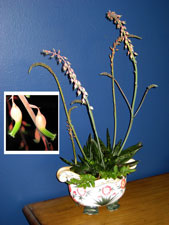Resource Library
Plant of the Week: Ox Tongue (Gasteria)
The University of Arkansas System Division of Agriculture does not promote, support or recommend plants featured in "Plant of the Week." Please consult your local Extension office for plants suitable for your region.
Plant of the Week
Ox Tongue
Latin: Gasteria

Even in times of difficulty, it's always possible to learn something. The recent ice storm sent limbs crashing through the roof of my hobby greenhouse, and try as I did, I couldn't keep enough heat in to stop things from freezing. Nearly all my orchids, all of my begonias and most of my succulents turned to mush. But not the gasterias.
'Gasterias are a group of South African succulents related to aloes and Haworthias that are now all classified in the asphodel family, a breakout from the overly large lily family. Gasterias often go by the common name ox tongue because the leaves are tongue shaped and covered by a series of white, warty outgrowths producing a sandpaper-like texture.
'Gasterias tend to have what botanists call a "distichous" leaf arrangement, which means leaves are arranged opposite one another along a central axis. In some species, the axis spirals as the stem elongates, while in others, the leaves are loosely arranged in a rosette. None of the gasterias have the tight rosette arrangement of leaves found in the aloes or Haworthias. To complicate their identification, immature plants often have a different leaf arrangement than mature plants.
'Gasterias were given the Latin name for stomach because the inch-long flowers have a pink, inflated, stomach-like pouch. Flowers appear in early spring in the greenhouse on long, variously arranged branched inflorescences held well above the foliage.
'Quite by accident, I had assembled a large assortment of gasterias. About four years ago, I assembled my succulents together on a bright patio in late spring. By chance, several species began flowering, and before long, seed had formed. Never missing an opportunity to grow something new from seed, I gathered the seed and planted them out. The first year, the seedlings were tiny, only reaching transplant size a year later. By the time of the great freeze, many of these four-year-old plants were beginning to send up bloom spikes.
'I suspect the gasterias are hybrids because individual plants are self-incompatible and must receive pollen from a different plant if seeds are to form. The seeds collected from the various plants generally resemble their parents, but there is a fair amount of variability in the progeny. All except for one species survived the 27-degree temperature, possibly an indication that G. brachyphylla, a species native to the mountains of interior South Africa that are described as "generally frost free," was involved in the hybrid mix.
'Gasterias are easy to care for as houseplants. I've kept mine in a cool, relatively dimly lit bedroom over winter where they are kept quite dry over winter. In the summer, plants are moved outside to a bright, but shaded, location where natural rainfall provides for most of their water needs. Overwatering is the most common problem associated with this group of succulents.
'Like most succulents, they need a well drained, gritty potting soil. Fertilization should be minimal during the winter and generally delayed until spring when the plants can be moved outside for the summer. A slow release fertilizer applied in April will provide all the nutrition the plants need for the coming season.
'New plants can be propagated by division of offsets in the spring, by leaf cuttings or by seed. Seed germinate quickly once planted.
By: Gerald Klingaman, retired
Extension Horticulturist - Ornamentals
Extension News - March 13, 2009
The University of Arkansas System Division of Agriculture does not maintain lists of retail outlets where these plants can be purchased. Please check your local nursery or other retail outlets to ask about the availability of these plants for your growing area.